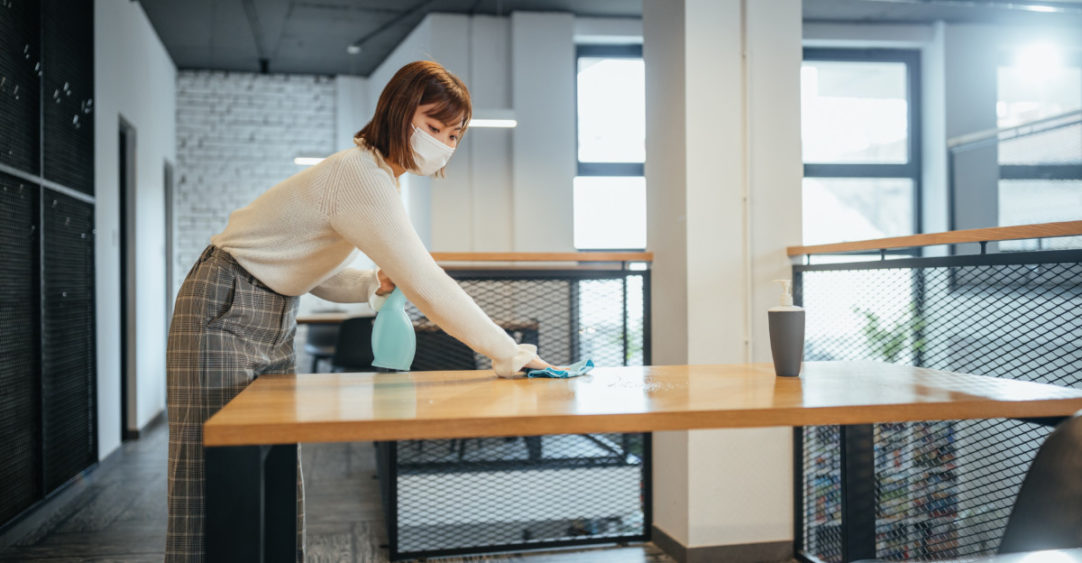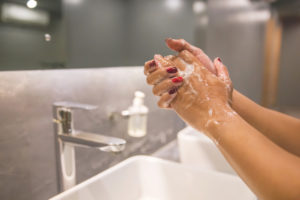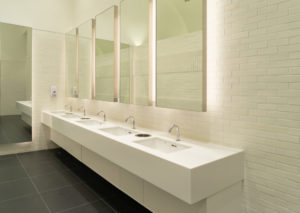
SSR WELL Health-Safety Rating Journey: Keeping Things Clean
When COVID hit, the first thing that we all started thinking about was how to best clean and sanitize spaces and surfaces to reduce the potential spread of viruses. This involved not only the type of cleaning products used but also a deeper look at the amount of “high-touch” surfaces a person can encounter during a typical day. The WELL Health-Safety rating has a dedicated category for Cleaning and Sanitization that provides guidelines for a healthier space.
SC1 Support Handwashing

Despite hand washing, hands can only become as clean as the surrounding environment. This feature focuses on reducing the potential for contaminant transfer to occupants during the process of handwashing. This applies to ALL sinks where handwashing is expected. That includes bathrooms, break rooms, food prep areas, wellness/mother’s rooms, and others within a facility. The feature focuses on two main parts: soap containers and hand drying.
- To reduce the potential for contamination of soap containers, the feature requires sealed cannister/bag type or single use dispensers, or containers that are washed and disinfected before refilling. No top-offs allowed! A fragrance-free soap option is also a must. The chemicals used to provide fragrance can cause skin irritation for sensitive populations.
- Hand drying must occur through paper towels or hand dryers. Since hand dryers’ dry hands through air directly recirculated from the bathroom, the dryers should be equipped with HEPA filters.
- Signage displaying steps for proper hand washing should be present. Visual cues can improve compliance.
SC2 Reduce Surface Contact

This feature focuses on two methods of surface touch reduction so as to lower the potential for disease transmission through surface. Either of these options may be pursued by a project to achieve this feature.
- Perform a surface touch assessment crating an inventory of all the high-touch surfaces and/or person-person contact points (e.g. security, reception) a building occupant may encounter when using the facility. Provide temporary and/or permanent measures to reduce frequency of contact, if possible (e.g. touch-free faucets, transparent partitions, ticketless entry, voice-activated elevators, etc.). List the circumstances and timeline for how temporary measures will be implemented
- Provide permanent surface touch management through hands-free operation (through foot, voice, sensor or personal device) for at least 3 of the following: entry doors, elevators, all water bottle fillers, faucets, soap and paper towel dispensers, or several others detailed in the credit. Projects must also provide hand hygiene support near high-touch surfaces that support mobility and accessibility such as handrails, tactile maps, push to open door buttons, and others. Lastly, projects must establish rules and expectations for usage and cleaning of shared tools and devices (e.g., copiers, appliances, fitness equipment, utensils) for regular occupants.
SC3 Improve Cleaning Practices
A detailed written policy for cleaning operations is required to confirm the level of cleanliness of a space as well as the health of occupants and cleaning staff. This feature lists out the specific cleaning policy requirements project should have in place which can be printed and taken directly to cleaning vendors for confirmation. A project should review all the policies and procedures that are used to clean areas of occupancy by the project. For some office projects, this would include core bathrooms which may be outside some tenant project boundaries. Therefore, this feature may require coordination with the building landlord, property manager, or janitorial vendor.
SC4 Select Preferred Cleaning Products
What a person uses to clean with can sometimes be more hazardous than what they are trying to clean up! This feature provides guidance on how to review the cleaning and sanitization products used within a building to determine their level of hazard to building occupants. Similar to the scope note for SC3, this feature may require coordination with the building landlord or property manager as well as access to the janitorial closet to review the products used for a project. Most products are required to have SDS or hazard labels shown and any products with Category 1, 1A, or 1B ingredients are considered non-compliant.
SC5 Reduce Respiratory Particle Exposure
Respiratory particles are known to spread many viral diseases, this feature promotes design and policy strategies to minimize some instances of contact between building occupants. Social distancing strategies and physical barriers between occupants can help reduce risk and are required for this feature. Some type of separated or one-way circulation pathways are another required strategy. Increased communication on occupant behavior and expectations (e.g. distancing, face coverings or PPE) are required for all shared spaces such as meeting rooms, workspaces, and communal kitchens. Projects must be proactive in educating occupants on the practices implemented at the facility, the rationale for their use, and what is expected of all occupants in order to occupy the space. The WELL Health-Safety Rating was designed to promote trust and transparency between building owners and occupants. Educating occupants on the measures taken by the project and why is not only encouraged, but required by most features.

SSR’s Top Picks
Based on the requirements of the above features, a site visit was performed at each of the SSR offices under certification to determine which of the features would be possible for which projects. Since SSR leases all our office space, coordination with landlords and property managers was required to gather the information for each location. Priority was placed on Reducing Respiratory Particle Exposure, specifically to address COVID-19 concerns for occupants and is documented through a corporate policy implemented at all SSR offices. SSR has increased cleaning in their spaces, but to reduce the amount of coordination with outside vendors for documentation, the Cleaning Practices feature was not pursued at this time. Some of the offices achieved an additional point for Preferred Cleaning Products. Overall SSR has gathered at least 8 points towards the minimum 15 required for certification.
Follow SSR’s Journey
During our next edition, our resident WELL Accredited Professional, Hannah Walter, will continue to dive into more detail about SSR’s pursued credits and the coordination and documentation required for each.
Debrief
Air & Water Quality – Maintenance
Air & Water Quality – Engineer Required
Keeping Things Clean
First Things First – How Much?
SSR Pursuing Well Health-Safety Rating
International WELL Building Institute, IWBI, the WELL Building Standard, WELL v2, WELL Certified, WELL AP, WELL Portfolio, WELL Portfolio Score, The WELL Conference, We Are WELL, the WELL Community Standard, WELL Health-Safety Rating, WELL Health-Safety Rated, WELL Workforce, WELL and others, and their related logos are trademarks or certification marks of International WELL Building Institute pbc in the United States and other countries.








